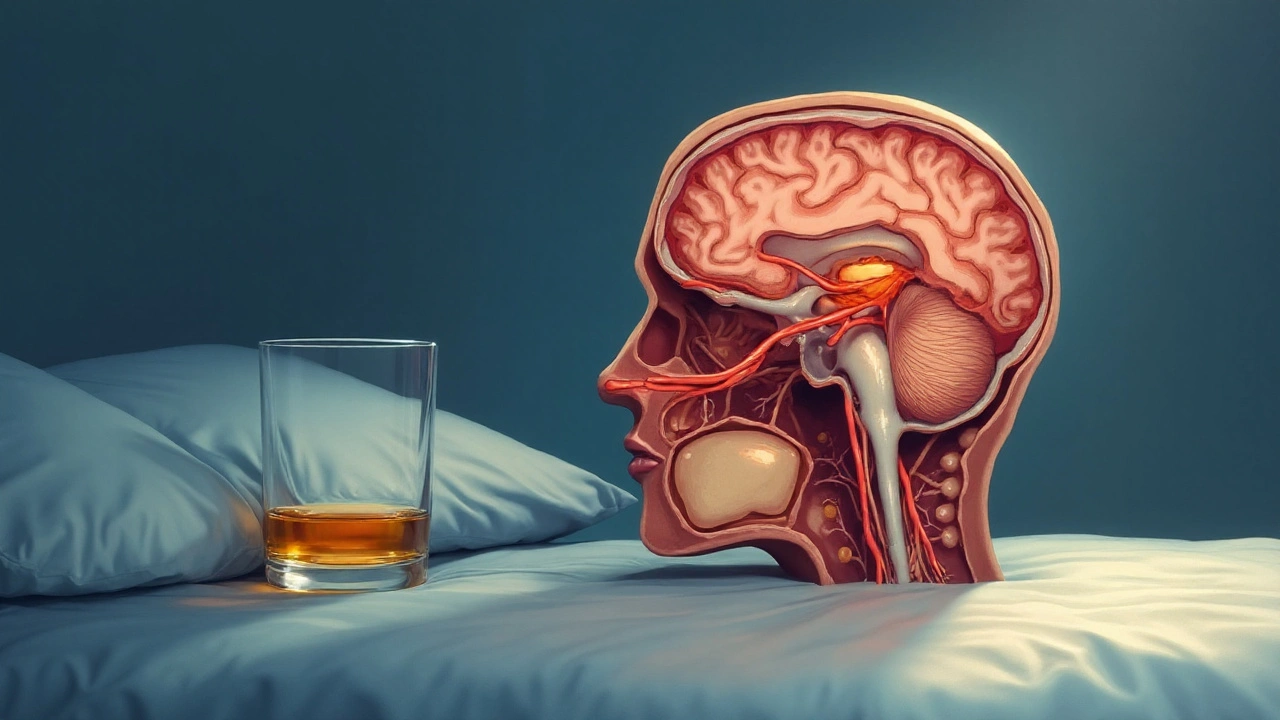Alcohol consumption is a behavioral exposure that involves drinking beverages containing ethanol. It is quantified by average drinks per day, binge episodes, and lifetime intake. In Australia, the National Health Survey reports a median intake of 7.5 drinks per week for adults.
Subarachnoid hemorrhage (SAH) is a type of stroke caused by bleeding into the space between the brain and its outer covering. SAH accounts for roughly 5% of all strokes but carries a 30‑40% mortality rate within the first month.
Cerebral aneurysm is a localized dilation of a cerebral artery wall that can rupture and trigger SAH. Approximately 2-3% of the adult population harbor an unruptured aneurysm.
Hypertension is a chronic elevation of arterial blood pressure, traditionally defined as ≥140/90 mmHg. It is a leading modifiable risk factor for both aneurysm formation and rupture.
Smoking is a habitual inhalation of tobacco smoke, delivering nicotine and thousands of toxins to the vasculature. Current smokers have up to a 2‑fold increased SAH risk.
Genetic predisposition is a heritable set of DNA variants that raise susceptibility to aneurysm formation, such as defects in the COL3A1 gene. Family history doubles the odds of SAH.
World Health Organization (WHO) guidelines are global recommendations that define safe drinking limits (no more than 2 standard drinks per day for men, 1 for women) and advise against binge drinking.
Quick take‑aways
- Heavy or binge drinking raises SAH risk by roughly 1.5‑2times compared with abstinence.
- Moderate intake shows a mixed picture; some studies hint at a slight protective effect, but the evidence is weak.
- Alcohol amplifies other risk factors - especially hypertension and smoking - creating a synergistic danger.
- Following WHO limits keeps the added SAH risk under 10% for most adults.
- Personalized advice should factor in age, gender, family history, and existing cardiovascular conditions.
Why does alcohol matter for SAH?
Alcohol influences the brain’s blood vessels through three main pathways:
- Blood pressure spikes. Acute ethanol ingestion triggers sympathetic activation, raising systolic pressure by 5‑15mmHg within an hour. Repeated spikes strain arterial walls and predispose aneurysms to rupture.
- Vessel wall remodeling. Chronic exposure impairs collagen synthesis and promotes elastin degradation, weakening the media layer that supports cerebral arteries.
- Coagulation changes. Ethanol reduces platelet aggregability and alters fibrinolysis, making bleeding more likely once a vessel ruptures.
These mechanisms link directly to the cerebral aneurysm entity described earlier, explaining how drinking turns a silent lesion into a catastrophic bleed.
What the numbers say: epidemiology of alcohol and SAH
Large‑scale cohort studies from the United States, Europe, and East Asia consistently report an exposure‑response curve. A 2022 meta‑analysis of 15 prospective datasets (over 2million participants) found:
- Zero to low consumption (0‑1 drink/day) - baseline risk.
- Moderate consumption (1‑2 drinks/day for women, 2‑3 for men) - relative risk (RR)≈0.9 (95%CI0.78‑1.04), not statistically protective.
- Heavy consumption (≥4 drinks/day) - RR≈1.6 (95%CI1.30‑1.98).
- Binge episodes (≥5 drinks on a single occasion) - RR≈1.8 (95%CI1.45‑2.23).
These data align with Australian Stroke Foundation reports that attribute roughly 12% of SAH cases to hazardous drinking patterns.
How dose‑response works: a comparison of drinking levels
| Consumption category | Average drinks per day | Relative risk (RR) | Confidence interval |
|---|---|---|---|
| Abstinent | 0 | 1.00 | Reference |
| Low | ≤1 (women) / ≤2 (men) | 0.95 | 0.82‑1.10 |
| Moderate | 1‑2 (women) / 2‑3 (men) | 0.92 | 0.77‑1.09 |
| Heavy | ≥4 | 1.58 | 1.30‑1.92 |
| Binge | ≥5 on one occasion | 1.81 | 1.45‑2.26 |

Interaction with other risk factors
Alcohol rarely acts alone. The biggest danger appears when it co‑exists with hypertension and smoking. A 2019 case‑control study from Melbourne showed:
- Patients with both heavy drinking and uncontrolled hypertension had an odds ratio (OR) of 3.4 for SAH.
- Adding current smoking raised the OR to 5.1, indicating a multiplicative effect.
Genetic predisposition also magnifies alcohol’s impact. Individuals carrying the COL3A1 mutation who drink heavily experience a 2‑fold higher rupture rate than non‑drinkers with the same mutation.
Practical guidance: staying within safe limits
Translating research into everyday choices hinges on the WHO guidelines. Key take‑aways for adults:
- Limit to ≤2 standard drinks per day for men and ≤1 for women.
- Avoid any occasion where you consume ≥5 drinks (binge threshold).
- If you have hypertension, a personal physician may recommend even stricter limits or abstinence.
- Regular screening for aneurysms (e.g., MR angiography) is advised for anyone with a strong family history plus any pattern of heavy drinking.
In practice, a 45‑year‑old male with mildly elevated blood pressure who enjoys a few beers on weekends should aim for 1‑2 drinks on those days and monitor his blood pressure weekly.
Related concepts and next steps
Understanding alcohol’s role opens doors to other vascular topics:
- Stroke subtypes. Ischemic stroke, intracerebral hemorrhage, and SAH each have distinct relationships with alcohol.
- Alcoholic liver disease. Liver dysfunction can worsen clotting, indirectly affecting bleed risk.
- Public health policies. Taxation, advertising restrictions, and brief intervention programs have proven to lower hazardous drinking rates.
Readers interested in a deeper dive might explore "Alcohol and Ischemic Stroke Risk" or "Screening for Unruptured Cerebral Aneurysms" as logical follow‑up topics.
Bottom line
While a glass of wine now and then is unlikely to tip the scales, heavy or binge drinking meaningfully raises the chance of a subarachnoid hemorrhage. The risk compounds with high blood pressure, smoking, and genetic vulnerability. By adhering to WHO limits, managing hypertension, and staying smoke‑free, most adults can keep the added SAH risk under 10%.

Frequently Asked Questions
Does occasional binge drinking increase SAH risk?
Yes. Even if binge episodes are infrequent, each episode spikes blood pressure and stresses arterial walls, raising the short‑term rupture risk. Studies show a relative risk of about 1.8 per binge episode compared with regular moderate drinking.
Is there a protective effect of low‑to‑moderate alcohol intake?
Evidence is mixed. Some cohort analyses hint at a slight reduction in SAH risk for light drinkers, but confidence intervals often cross 1.0, meaning the effect may be due to chance. Until more robust data emerge, the safest advice is to stay within WHO limits.
How does alcohol interact with hypertension to affect SAH risk?
Alcohol raises systolic pressure acutely and can worsen chronic hypertension. When both are present, the odds of aneurysm rupture rise multiplicatively; a heavy‑drinking hypertensive patient may have a three‑ to five‑fold higher SAH risk than a normotensive non‑drinker.
Should people with a family history of aneurysms avoid alcohol completely?
Complete abstinence is the most risk‑averse choice, especially if the family history includes early‑onset ruptures. If moderate intake is preferred, it should stay well below WHO limits and be coupled with regular blood pressure monitoring and imaging follow‑up.
What screening is recommended for people who drink heavily?
Magnetic resonance angiography (MRA) or computed tomography angiography (CTA) every 5‑10 years is advised for high‑risk individuals (heavy drinkers with hypertension, smoking habit, or positive family history). Early detection of unruptured aneurysms allows elective repair, dramatically lowering mortality.


Spencer Riner
That acute spike in systolic pressure after a few drinks really sets the stage for a bad outcome, especially if you already have an aneurysm lurking. Even a night out can push your numbers into a dangerous zone, so keeping tabs on your blood pressure is key.
Joe Murrey
i dont think a couple beers on the weekend are worth the risk.
Tracy Harris
In the annals of cerebrovascular pathology, the interplay between ethanol consumption and subarachnoid hemorrhage (SAH) assumes a position of paramount importance. First, the hemodynamic perturbations precipitated by acute alcohol ingestion engender a non‑trivial surge in systolic pressure, frequently ranging between 5 and 15 mmHg. This elevation is not merely a transient curiosity; it imposes mechanical stress upon the fragile arterial walls that harbor aneurysmal dilatations. Second, chronic exposure to ethanol compromises the structural integrity of the vascular media through impaired collagen synthesis and accelerated elastin degradation, thereby predispositioning the vessel to rupture. Third, the coagulopathic milieu induced by alcohol – attenuated platelet aggregation coupled with altered fibrinolytic activity – diminishes the body’s capacity to staunch hemorrhage once a breach occurs. Moreover, epidemiological data from expansive cohort studies corroborate these mechanistic insights, revealing a dose‑response relationship wherein heavy drinking (≥4 drinks per day) confers a relative risk approximating 1.6, while binge episodes amplify this risk to nearly 1.8. It is also noteworthy that the synergistic effect of concomitant hypertension and tobacco use escalates odds ratios to the magnitude of fivefold, underscoring the multiplicative danger of clustered risk factors. Genetic predispositions, such as COL3A1 mutations, further exacerbate vulnerability, rendering the alcohol‑induced risk even more pronounced in susceptible subpopulations. While the notion of a protective effect from low‑to‑moderate consumption has periodically surfaced, the confidence intervals surrounding such findings consistently intersect unity, thereby precluding any definitive endorsement of a cardioprotective benefit in the context of SAH. Consequently, adherence to World Health Organization guidelines – limiting intake to ≤2 standard drinks per day for men and ≤1 for women – remains the most pragmatic strategy to mitigate added SAH risk. Clinical prudence also dictates that individuals with established hypertension, a smoking habit, or a familial history of aneurysmal rupture entertain stricter limits, or even abstinence, coupled with periodic vascular imaging. In sum, the convergence of hemodynamic, structural, and coagulopathic mechanisms elucidates why alcohol, particularly in hazardous patterns, serves as a formidable catalyst for subarachnoid hemorrhage.
Sorcha Knight
Wow, that’s a beast of a summary 😲 – basically, pour too much booze and you’re practically inviting a brain bleed. It’s wild how the blood‑pressure spikes and the wall‑weakening combo can turn a casual night out into a life‑or‑death gamble.
Jackie Felipe
i think it s really scary when you read that even a few drinks can cause big damage. make sure to check your blood pressure and maybe cut down on the wine.
debashis chakravarty
From a strict methodological standpoint, the cited meta‑analysis suffers from heterogeneity in exposure definitions, which weakens the causal inference. Nonetheless, the biological plausibility remains intact, and the data are enough to warrant caution.
Daniel Brake
Philosophically, one could argue that individual liberty permits moderate drinking, yet the collective burden of preventable SAH events suggests a societal responsibility to educate and perhaps regulate consumption patterns.
Avinash Sinha
Honestly, binge drinking is just asking for trouble.
ADAMA ZAMPOU
Considering the statistical insignificance of a protective effect at low levels, the prudent recommendation aligns with the WHO limits, thereby minimizing the incremental risk while preserving personal enjoyment.
Liam McDonald
I feel for anyone juggling hypertension and a drinking habit – the odds are really stacked against you.
Adam Khan
From a pathophysiological perspective, the synergistic interaction between ethanol‑induced sympathetic activation and pre‑existing vascular remodeling creates a perfect storm for aneurysm rupture – a classic example of multifactorial etiology.
rishabh ostwal
The data are clear, yet many still dismiss the risk as negligible – a classic case of wishful thinking overriding empirical evidence.
Kristen Woods
In reality, if you have a family history of aneurysms, the safest route is complete abstinence; anything less is simply reckless.
Carlos A Colón
Looks like the only thing you’re really good at is drinking and not caring about the consequences.
Aurora Morealis
Interesting data but the takeaway is simple - moderation matters.
Sara Blanchard
Let’s remember that cultural practices around alcohol vary, but the health messages stay consistent: stay within the limits and keep an eye on your blood pressure.